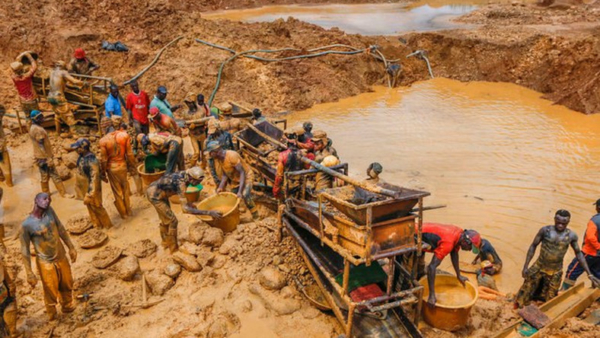|
Getting your Trinity Audio player ready...
|
Galamsey, a term derived from the Ghanaian pidgin that translates to “gather and sell,” refers to illegal small-scale gold mining activities. While it may seem like a local economic boon, galamsey has devastating environmental consequences, particularly concerning water quality. The destruction of water sources not only threatens biodiversity but also poses severe public health risks, leading to a rise in waterborne diseases. Understanding these implications is crucial for developing effective interventions and policies.
Galamsey operations often involve the use of harmful chemicals such as mercury and cyanide, which are used to extract gold from ore. These toxic substances frequently leach into local water systems, polluting rivers and groundwater. Mercury, in particular, is a potent neurotoxin that accumulates in the environment and within the food chain, posing long-term health risks to communities.
The excavation process not only releases these harmful chemicals but also causes soil erosion and sedimentation in water bodies, diminishing water clarity and quality. As water sources become contaminated, the ecosystem suffers, leading to a decline in fish populations and other aquatic life. This not only disrupts local food chains but also impacts communities reliant on these resources for their livelihoods.
Widely used in artisanal gold mining, mercury binds with gold to form an amalgam. However, when released into the environment, it can transform into methylmercury, a more toxic form that bioaccumulates in fish and other aquatic organisms. Human consumption of contaminated fish poses significant health risks, including neurological and developmental disorders, particularly in children.
Used for its effectiveness in gold extraction, cyanide can leach into water sources, leading to acute and chronic health problems. Even small concentrations can be lethal to aquatic life, leading to biodiversity loss. In humans, cyanide exposure can cause respiratory failure, cardiovascular issues, and even death.
Other heavy metals, such as lead and arsenic, can also be released during mining processes. These contaminants can lead to a range of health problems, including kidney damage, developmental issues in children, and increased cancer risk.
The contamination of water sources has direct implications for public health. When people consume or come into contact with polluted water, the risk of contracting waterborne diseases escalates.
Some of the most concerning diseases associated with contaminated water from galamsey activities include:
- Cholera: This acute diarrheal infection is caused by ingesting contaminated water or food. Cholera can lead to severe dehydration and, if untreated, can be fatal within hours. The bacteria thrive in environments where sanitation is poor, making galamsey-affected areas particularly vulnerable.
- Typhoid Fever: Caused by the Salmonella typhi bacteria, typhoid fever spreads through contaminated food and water. Symptoms include prolonged fever, fatigue, headache, and gastrointestinal issues. In areas where galamsey has compromised water quality, outbreaks of typhoid are more common.
- Hepatitis A: This viral infection is transmitted through consumption of contaminated food or water. Hepatitis A can cause liver inflammation, leading to symptoms such as jaundice, fatigue, and abdominal pain. Regions affected by galamsey face increased risks, especially among communities with inadequate sanitation.
- Dysentery: Both bacterial and amoebic dysentery can spread through contaminated water. Dysentery leads to severe diarrhea, abdominal pain, and fever, resulting in dehydration and further health complications. Areas affected by galamsey often see spikes in these infections due to poor water quality.
- Guinea Worm Disease: While not as prevalent as it once was, Guinea worm disease can still pose a threat in areas with contaminated water. The larvae enter the human body through drinking water containing infected copepods. The disease causes debilitating pain and can lead to secondary infections.
- Children and vulnerable populations are disproportionately affected by waterborne diseases. In many communities engaged in galamsey, access to clean water and proper sanitation facilities is limited. The health consequences of contaminated water can lead to school absenteeism, reduced workforce productivity, and increased healthcare costs.
Moreover, the economic implications extend beyond individual health. Communities suffering from waterborne diseases may see diminished agricultural yields and reduced fish catches, exacerbating food insecurity. As healthcare systems become overwhelmed with disease outbreaks, local economies can spiral into further decline.
Addressing the public health risks associated with galamsey requires a multi-faceted approach. Key strategies include: - Strengthening Regulation: Governments need to enforce stricter regulations on illegal mining activities, ensuring that environmental and public health standards are met.
- Community Education: Raising awareness about the health risks of consuming contaminated water is crucial. Education campaigns can empower communities to seek alternatives and advocate for better water management.
- Investment in Clean Water Infrastructure: Building and maintaining access to clean water and sanitation facilities can significantly reduce the incidence of waterborne diseases.
- Collaborative Research and Monitoring: Continuous monitoring of water quality in areas affected by galamsey can help identify contamination sources and track disease outbreaks.
The illegal mining activities known as galamsey are not merely an environmental concern; they are a significant public health threat. The destruction of water resources and the release of harmful chemicals lead to a cascade of health issues, particularly through the rise of waterborne diseases. By addressing the root causes of galamsey and prioritizing community health and environmental protection, we can create a healthier future for affected populations. It is imperative that stakeholders, from governments to local communities, collaborate to combat the devastating effects of this illegal activity and safeguard precious water resources.


